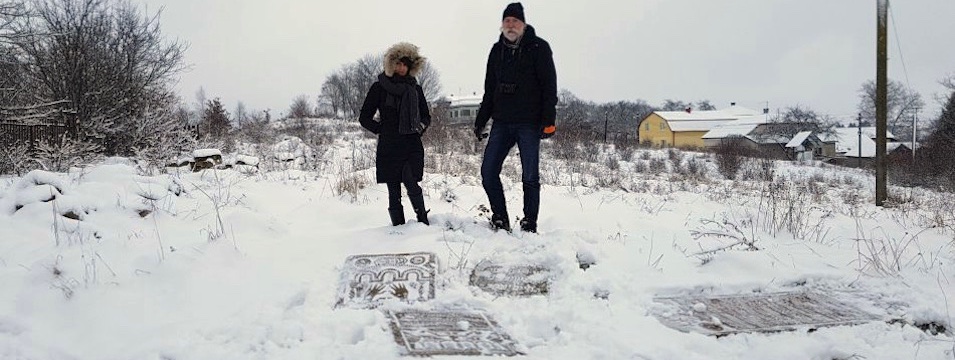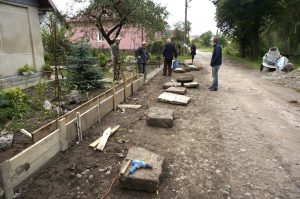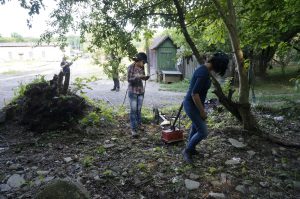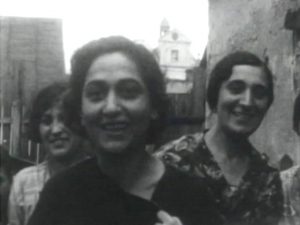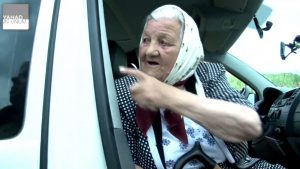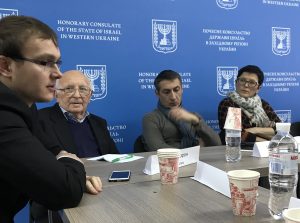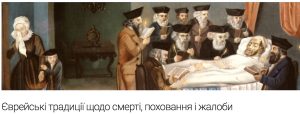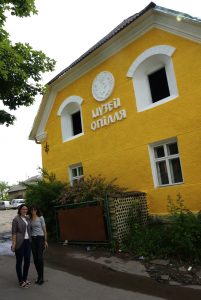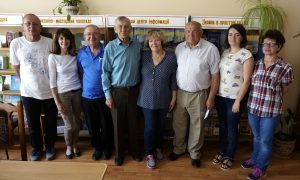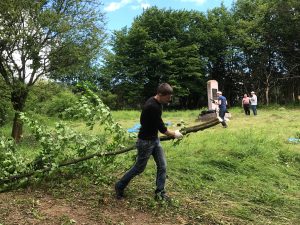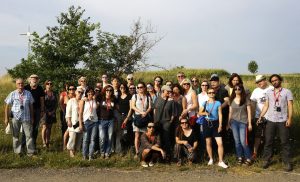This is an informal annual report for Rohatyn Jewish Heritage (RJH) for the calendar year 2017, in essence a year-in-review summary of our project progress and events, with an outline of our finances as well. The summary seems long, but (for us, at least) it helps to organize the sometimes chaotic mix of activities we had this past year. It’s also probably the most hyper-linked article we’ve written to date, so hang on…
![]() Ця стаття також доступна українською.
Ця стаття також доступна українською.
ADMINISTRATION
We registered our Ukrainian non-profit non-governmental organization (NGO) «Єврейська спадщина Рогатина» (Rohatyn Jewish Heritage) under organization code 41047464 in late 2016, and began funding and operating it in early 2017. We also hired two employees (Marla and me) to run the NGO, paying our salaries (plus taxes, benefits, and accounting) out of funds we are donating to the NGO from our personal US savings (for now).
In July we signed a memorandum of cooperation with the City of Rohatyn, acknowledging our mutual interest in preserving and promoting Jewish heritage in and around the city for the benefit of all. We had already been working informally with the City on several projects in town, and are happy to formalize our continuing cooperation on current and future projects. Joint work in 2017 included headstone recovery, mass graves survey preparations, and museum exhibition development, as described below.
We want to thank LawCraft LLC in Lviv for their significant strategic and tactical help in all of these administrative tasks.
PROJECTS
This was by far the most active project year for us, with progress in every month throughout the year. All of our continuing projects have separate pages accessible from the Projects menu on the website, but here is a summary for 2017:
Headstone Recovery: This is the longest-running of our projects, now in its seventh year. We estimate there are now about 600 headstone fragments which we have helped to collect and return to the old Jewish cemetery, up from 40~50 which had been collected in the new cemetery before our first efforts in 2011. In 2017, 25 large stone fragments were recovered from under vul. Drahomanova in Rohatyn, and a few others were brought to Mykhailo Vorobets or to the cemetery by local residents throughout the year; another group of stones was found and now awaits recovery by vul. Zelena. Mr. Vorobets, who turned 83 in 2017, continues to manage the recovery of Jewish headstones and payment of laborers without taking any compensation himself. This project will continue for decades, long after both Mr. Vorobets and we are gone. We still need to find a replacement local contact to relieve Mr. Vorobets of his volunteer activities in headstone recovery management and light maintenance at the mass grave memorials; he is helping with that search in town.
Old Jewish Cemetery: The old cemetery continued its centuries of service to the community, receiving this year’s recovered Jewish headstones plus a large number of visitors, many for the first time – and many of whom came with us. In late May, as a related task of the mass graves survey (see below), Dr. Dante Abate collected a large number of photographs of a few surviving and recovered headstones in the cemetery, and assembled several digital 3D visualizations of the stones as a demonstration of possible heritage documentation methods for future use in our program (see the archaeology report for more info). In November, we supported an engineer from ESJF (European Jewish Cemeteries Initiative) while he made geodesic measurements in and around the cemetery to enable a draft plan and cost estimate for replacing the perimeter fence; we’ll find out soon whether the cemetery is a candidate for ESJF’s new projects in 2018.
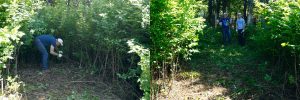
Sashko blazes a path through the undergrowth in the new cemetery, and emerges on the other side. Photos © 2017 Jay Osborn.
New Jewish Cemetery: Thanks to our friends at the Lviv Volunteer Center (LVC) and a number of Rohatyn residents, to support the mass graves survey the cemetery was almost completely cleaned and cleared of wild-growing vegetation over two long and difficult days in May. One part of the small cemetery had been inaccessible due to a dense and thorny thicket, which was cleared to reveal a previously unknown headstone! Several damaged or dead trees were removed, along with a broad area of woody brush, and several garbage piles. The new cemetery also got the attention of Dr. Abate’s 3D photogrammetry work, and several of the fallen stones were captured as documentation demonstrations.
Jewish Mass Graves: We held a small but important memorial event at the south mass grave site in March to mark the 75th anniversary of the first major aktion against the Jewish community of Nazi-occupied Rohatyn; the ceremony was led by Rabbi Kolesnik of Ivano-Frankivsk and attended by friends and colleagues from Rohatyn, Lviv, and afar. Returning to this site a few months later, the largest project for us in 2017 was a nine-day non-invasive archaeological survey of Rohatyn’s WWII mass graves. The goal of the project was to define the geographical boundaries of the mass graves, which have been uncertain since late in the war, to enable better protection and commemoration of the sites. The scientific work was conducted by the Centre of Archaeology at Staffordshire University and concluded with clear definition of two mass graves (one at both the south and north sites) plus a second possible grave at the north site. We hope to continue the work beyond the surveyed areas sometime in the future, to see whether all of the graves have been detected and defined.
Digital Information: This was also a key project for 2017, primarily in further development of the program website. This effort is important enough that we have detailed it separately below.
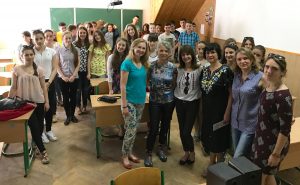
A wonderful exchange with Rohatyn students and teachers, plus Ruthy from Israel, in May. Photo © 2017 Marla Raucher Osborn.
Education: Through this year our education focus has been primarily to develop the website as a resource for studying the history of the Jewish community of Rohatyn, but we led or participated in several other interesting educational efforts and events in 2017, and hope to do much more in the coming years. At the invitation of the City of Rohatyn and with the support of Rohatyn Jewish descendants around the world, we contributed Jewish history and culture information specific to the Rohatyn area to a renewed “Opillya” Museum of local history, now at a newly-renovated historic building in town, with exhibitions in development for opening in 2018. We also managed the delivery of Jewish artifacts and books from donors in Israel and North America, as well as the transfer of Jewish-related paper scraps from before and during WWII found in the Internat school in Rohatyn, preserved temporarily by Hesed-Arieh in Lviv while the Rohatyn museum was in development.
Through the generosity of Rohatyn Jewish descendants, we were also able to acquire permission from YIVO to display a short but remarkable 1932 film shot in Rohatyn at the museum, and eventually to make that film publicly available on the YIVO website as well. Throughout the year, we participated in several topical meetings and seminars, including with Rohatyn educators, with the international organizations Centropa and SII in their Trans.History project, at an English-language encounter with Rohatyn students (and informal encounters during our physical project work in town), and as part of an EHRI-sponsored regional Holocaust seminar hosted by our friends at the Lviv Urban History Center and Hesed-Arieh. And somehow, our work appeared in a number of media outlets with both Jewish and Ukrainian focus, which helped spread the word about the issues which matter to us.
Other Projects: Not all of our project work in 2017 was planned in advance; frequently we discovered or were given opportunities to help re-connect Rohatyn’s Jewish history and heritage with the modern town and the region. For example, our year began with a chance to help Rabbi Kolesnik, who has been a great supporter and guide to our program in Rohatyn: At the Rabbi’s suggestion, we made a call to Rohatyn Jewish descendants and others on Facebook and in online family history groups, and donors (very!) quickly provided the funds to order and ship 32 new Hebrew-Russian prayer books (siddurim) to the Rabbi’s synagogue in Ivano-Frankivsk for use by the local Jewish community there. The French NGO Yahad – In Unum offered us access to their 2016 video interviews with Ukrainian witnesses to wartime Jewish persecution in Rohatyn and nearby villages, with background testimony about pre-war interactions between the ethnic groups in the area; we translated and summarized the interviews as a resource for Holocaust-era history research and plan a complete transcription of the interviews in 2018.
In addition to the education seminars described above, we were invited to two round-table forums on Jewish heritage in the Lviv and nearby oblasts, in February and again in December, where we discussed issues common across towns in western Ukraine with other local activists, to network ideas and resources. As part of what we believe will be a growing effort by us and others, and with the leadership of the Rohatyn “Opillya” Museum, we started to assemble information and materials to enhance local tourism by Jews and others, and we hosted cross-border educators and guides in Rohatyn to extend the network of knowledgeable tour leaders and developers who can make the most of visits to Rohatyn.
Two of our planned projects saw no progress in 2017, as expected. No new physical signage was developed for installation at the heritage sites and to direct visitors to the sites, but the Rohatyn “Opillya” Museum is working on strategies for tourist aids to all the heritage sites in town, and we have already offered our help to inform and integrate the Jewish sites with that project. We have gathered a small amount of addition information in 2017 to help document the synagogues of Rohatyn, but any physical work with the few surviving buildings is still out of scope for our program because of the cost and skills required. Both of these projects will get further attention in 2018.
WEBSITE
Our website is proving to be a useful tool for communicating about the Jewish heritage and history of Rohatyn, and about our project work, educational resources, and more. It’s also a good way for Ukrainians living in Rohatyn or with roots there to learn about the Jewish community which once made up a significant portion of the town’s residents, and for today’s Jewish descendants of Rohatyn families to learn about continuity and change in the town since WWII. It’s difficult for us to advance the website when physical heritage work is in progress, but in 2017 we used the darker months to work toward our website goals, and will continue that in 2018.
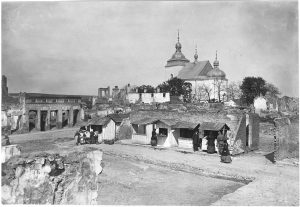
The burned town square of Rohatyn ca. 1916. Source: Bildarchiv Austria.
In addition to posting 20 heritage-related news articles in 2017 (this report will make 21), with the generous support of Rohatyn Jewish descendants (for their family histories and photographs) we significantly built the section on Jewish history of Rohatyn, adding new timelines covering the Great War and the interwar period in Rohatyn. We also added several new thematic history articles, including about the fascinating 1926 Polish declarations of friendship which students and teachers in Rohatyn sent to America, and a detailed survey of population censuses in Rohatyn over a 200-year period before WWII.
Jewish cultural topics remain a fascination for residents and historians of Rohatyn, as a means to understand the surviving heritage there and the history of their town. In response to questions raised by Rohatyn educators in 2016, in early 2017 we compiled references to and descriptions of Jewish death, burial, and mourning practices, and a short but important discussion about appropriate terms for Jews in the Ukrainian language in western Ukraine. Anticipating another question, we also used a variety of visual examples from Rohatyn’s recovered headstone fragments to discuss the art and meaning of symbols on Jewish grave markers. The interest in Rohatyn’s Jewish culture is strong in town, and we will do our best to continue adding new material to the website.
At the start of the year, we set ourselves a goal of making the website 100% bilingual (English and Ukrainian), a major challenge for us since we still have only very rudimentary Ukrainian language skills. Fortunately, we have very clever and industrious translators: between them, Viktoriia Serhiienko, Natalya Kurishko, and Svitlana Bregman have translated nearly the entire website into Ukrainian, so we can offer today’s Rohatyners a window into their town’s Jewish past in their native tongue. As of the end of 2017, we have Ukrainian versions of 67 news articles (every one from the beginning in 2011 through November 2017), all 9 main project pages, 9 thematic history articles (the key timelines just went to our translators before the end of the year), 5 Jewish culture articles (everything we have written in English), all 14 map-focused articles in the geography part of our education section, and more. Our translators have also tackled some large projects for us off of the website, including exhibition drafts for the Rohatyn “Opillya” Museum and technical reports from the mass graves survey. In all of this work they have exercised sensitivity to both languages and cultures, and we are very grateful to have their support and friendship.
VISITORS
We think we wore a groove in the road between Lviv and Rohatyn in 2017, from making so many trips there: 18 round trips, for 28 days and 10 nights in Rohatyn, with visits in every month except January. As part of several of those trips, we also visited Jewish and other sites in a number of the other towns and villages which have historically been in the Rohatyn district and with heritage, history, and family ties to the town of Rohatyn: Stratyn, Zhuriv, Kniahynychi, Perenivka, Bukachivtsi, Bilshivtsi, Koniushky, and Burshtyn. Further afield, and to advance our learning and to support our supporters, we also participated in Jewish heritage work projects in Staryi Sambir and Ralivka (in the Lviv oblast of Ukraine, both with the LVC), and Nasielsk (in Poland, with TMF).
But a highlight of 2017 for us was the large number of other interested visitors to Rohatyn, many of whom traveled there with us, to see and learn about the Jewish heritage and history of the town. Some of the visitors were friends who came for family history reasons, including Marla’s aunt Cheryl and uncle Reuben (son of Marla’s grandmother Annie who was born in Rohatyn) from the US, Witek and Ania Stępień from Poland, the Kransdorff family from South Africa and the UK (led by our friend and longtime supporter Alex Denysenko), plus Ruthy Erez (who was an essential and cheerful co-worker in site clearing during the mass graves survey) and David and Batya Kidron (whose mother was sheltered in an administration building basement by a Ukrainian man during WWII) from Israel.
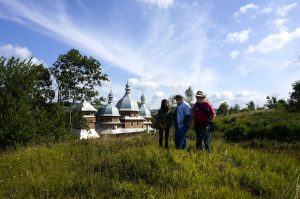
Marla with Steven and Bruce of The Matzevah Foundation at the top of Rohatyn’s old Jewish cemetery. Photo © 2017 Jay Osborn.
Several friends and colleagues braved the cold March air to stand with Rohatyn residents and us in a memorial gathering at the south mass grave, including Iryna Matsevko, Jennifer Dickinson, and Ben Cohen. Our friends at the Lviv Volunteer Center (LVC) and LawCraft LLC joined us several times in Rohatyn – or rather, we joined them as they labored hard on our behalf on both physical and administrative issues. Other friends visited Rohatyn with us in 2017 to plan for heritage work in 2018, including Steven D. Reece and Bruce Mussey of The Matzevah Foundation (TMF), and Hryhoriy Arshynov of ESJF (European Jewish Cemeteries Initiative). Threading an artistic (and humanistic) perspective through our connection to Rohatyn, we were also fortunate to visit with our friend and frequent traveling companion Christian Herrmann, photographer extraordinaire and self-guided documentarian of the often-empty spaces of former Jewish life in central Europe; it is always enlightening for us to see these places through his eyes.
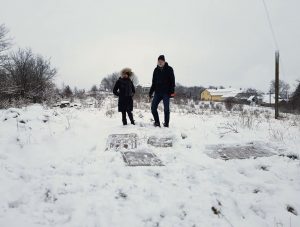
Rohatyn’s old Jewish cemetery and recovered matzevot, from a visit in late December. Photo © 2017 Sonia Engström.
The last month of the year brought snow to Rohatyn and visits in high contrast with our friend Tammy Hepps, who is building a rich heritage and history resource for her ancestors’ town of Homestead, Pennsylvania (and a model for our own efforts, with surprisingly similar issues and concerns to our program a third of the way around the world), and our Lviv-based Swedish friends Sonia Engström and Gustav Söderström, who write about the east of Europe from a northern perspective and with photographers’ eyes as well. The single largest number of Jewish-focused visitors in a single day during the year was the Rootka group we met with in Rohatyn in summer to review the heritage sites for their future reference as tour guides and planners; among the many friends from Poland on that visit were leader Agata Radkowska-Parka, Wacław Wojciechowski, Albert Stankowski, Wioletta Wejman, Agnieszka and Piotr Sewruk, Teresa Klimowicz, Łukasz Biedka, Karina Sokołowska-Folwarczny, and Ewa Bratosiewicz; another group led by activists of the related Shtetl Routes project (and friends) Emil Majuk and Monika Tarajko brought specialists in headstone art and translation to Rohatyn’s old Jewish cemetery for a documentary project to be developed in the future.
Through the year, our frequent trip companion and driver Vasyl Yuzyshyn supported us with transportation to and interpreting in Rohatyn, and with a kind touch that helped us engage with Rohatyn citizens to improve our connections to the town; his help has been a blessing for us in 2017, and we are grateful to call him a friend in our work and our life. Finally, we shared a very special trip to Rohatyn with Vasyl and the team from Staffordshire University’s Centre of Archaeology during the mass graves survey in 2017, when we didn’t just visit, we lived in Rohatyn for ten days of site work in spring; it was a sometimes difficult, sometimes sad, but often amusing time crossing cultural gaps all around, and we thank Caroline Sturdy Colls, Kevin Colls, Czelsie Weston, Dante Abate, and Marina Faka for their hard work and openness to all things in Rohatyn during our time together there.
FINANCE
Accounting for the NGO is complicated because we are still transitioning from US to UA banking, made erratic by ever-changing Ukrainian banking rules and procedures. We maintain dual-track personal and NGO bank accounts to stay flexible and reliable in covering project expenses, but we record and acknowledge all donations, and every donation goes directly to project expenses. We contribute additional money from our personal savings to cover project expenses which exceed donations, and all administrative and operational costs, including our own salaries. For the calendar year 2017, in US$ (some values are approximate because of fluctuating currency exchange rates; nominal here is set at US$1=26.5UAH, but today the rate is 28.0UAH):
Headstone Recovery and Cemeteries Projects (ongoing): US bank account start balance: +$ 5,612 --------------------------------------- cash held in Rohatyn (start) +$ 104 headstone recovery labor -$ 32 cash held in Rohatyn (end) -$ 185 US bank fees -$ 12 --------------------------------------- net change 2017: +$ 5,487 donations via GG +$ 3,914 Osborn personal contribution: +$ 113 (to cash held in Rohatyn) --------------------------------------- end balance: +$ 9,514 (projects are ongoing) Mass Graves Survey Project 2017 (one-time project): US bank account archaeological research -$24,247 pre-survey grounds prep -$ 639 logistics, housing, support -$ 3,200 est. currency, wire, other $ fees -$ 918 --------------------------------------- net change 2017: -$29,004 donations via GG +$ 4,637 donations via GoFundMe +$ 1,540 Osborn personal contribution: +$22,827 --------------------------------------- end balance: $ 0 (project is closed) NGO administration, salaries, etc.: UA bank account start balance: $ 0 --------------------------------------- legal and gov't fees: -$ 3,212 accounting fees: -$ 604 salaries+benefits+taxes out: -$ 2,417 salaries+benefits+taxes in: +$ 1,595 --------------------------------------- net change 2017: -$ 4,638 Osborn personal contribution: +$ 5,000 --------------------------------------- end balance: +$ 362 NGO operations: US bank account ground transport Lviv/Rohatyn: -$ 1,323 interpreting: -$ 700 printing+binding: -$ 283 est. website domain, hosting, apps: -$ 252 translations: -$ 615 books: -$ 379 archives research: -$ 305 --------------------------------------- net change 2017: -$ 3,857 Osborn personal contribution: +$ 3,857 --------------------------------------- end balance: $ 0
This summary may require updating after the first of the year to include late-year donations or expenses, and a final reckoning by our accountant.
Absent from this summary is the significant volunteer time donated by many friends and organizations to make some of these projects possible; we count that as a debt we hope to pay back by helping others. Some donations which were simple pass-thru or pass-by directly to other projects (e.g. artifacts and video rights for the museum, siddurim for the synagogue in Ivano-Frankivsk, etc.), and our own personal donations to non-RJH projects (e.g. regional heritage projects and work camps, books for the Rohatyn city library, etc.), plus routine tools and supplies (for landscape work, photography, software, etc.) are not listed here.
We want to thank Gesher Galicia, and in particular their membership chair Shelley Kellerman Pollero and CFO/treasurer Ann Gleich Harris, for making donations to Rohatyn Jewish Heritage tax-deductible for US taxpayers and simple for everyone.
LOOKING TO 2018
We hesitate to predict what we will do and accomplish in 2018, given the number of surprises each past year has brought, but as the new year begins we can at least outline our hopes:
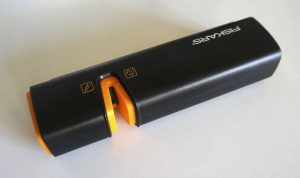
A small step toward next summer’s cemetery work: a tool for sharpening landscape cutting blades. Photo © 2017 Jay Osborn.
Projects: Next year, as every year, we will continue to fund and manage recovery of Jewish headstones from under the streets of Rohatyn, as needed. Our primary project focus for 2018 will be the old Jewish cemetery: a first organized clearing of wild vegetation, as a joint effort with The Matzevah Foundation, plus a start to planning for development of the cemetery as a memorial site to welcome visitors with improved access and information, and a display space for the recovered headstones. As part of the cemetery clearing project, TMF and RJH hope to purchase new landscaping tools, both manual and motorized, to leave with a regional volunteer organization at the end of the Rohatyn work – so those tools can continue to serve in similar work for the next several years. There is a chance also that ESJF may be able to find funding to replace the aging perimeter fence around the old cemetery and install new gating; we are awaiting their evaluation and proposal.
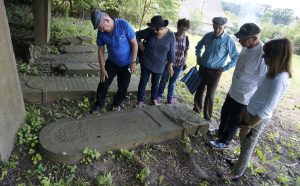
With the Kidrons and the Snitmans, reading a fallen headstone at Rohatyn’s new Jewish cemetery. Photo © 2017 Jay Osborn.
At the new Jewish cemetery, we plan to do a maintenance clearing of the cemetery, and we have submitted a proposal to Stowarzyszenie Magurycz to include uprighting the heavy fallen headstones there as one of their stone-centric volunteer work camps for 2018, and are awaiting their consideration. Next June will mark 75 years since the final large WWII aktion which resulted in the north mass grave; we will mark that anniversary with a memorial event, and during the year we will open discussion with the City of Rohatyn on ways to enhance protection and commemoration at each of the sites. We look forward to another year of cooperation with the City on the local Rohatyn “Opillya” Museum, including completion of the new exhibitions and collaboration on tourist routes and other information to welcome visitors to the city. With our colleagues in regional civil activist organizations, this may also be the year in which we can help add western Ukraine to European routes of Jewish heritage. We hope to continue our exchanges with Rohatyn and regional educators, to share what we have and to develop new resources; we also intend to apply for institutional and friends-network funding to start several new translation projects (English->Ukrainian and Ukrainian->English) of key memoirs, testimonies, and other texts on Rohatyn Jewish History.
Website: In 2018 we will overhaul a portion of our website to better highlight the permanent Jewish physical heritage in Rohatyn, separate from our ever-changing project work; that should help visitors and tour guides make Rohatyn a rewarding destination for educational and family-roots tourism. We will also continue to develop the history section of the timeline, with both the difficult Shoah period and the bright modern life of Rohatyn Jewish descendants. We look forward to the research and discussions with experts which will help us add new Rohatyn Jewish cultural articles as well, for both Ukrainian and Jewish audiences. The news articles will of course continue to appear as events and projects proceed.
Visitors: We anticipate another year of frequent visits to Rohatyn starting soon after the calendar turns to 2018, and we very much look forward to that. We already know that many of the same visitors from 2017 will visit again in the new year. The old cemetery clearing project will bring old and new friends from the US, Poland, western Ukraine, and elsewhere to Rohatyn. A very special Jewish genealogy event will be held in Warsaw next August, for the first time ever in Poland, and it’s likely that many attendees with roots in Galicia will cross the border into Ukraine before or after the conference to see ancestral family towns and villages; the very active Rohatyn District Research Group (RDRG) has organized gatherings at several past conferences and will have a strong showing in Warsaw, an easy transfer point to Lviv. But we also hope to welcome many new visitors who are curious about the town and its history, and who are open to the work-in-progress that we and others (in Rohatyn and beyond) are slowly advancing.
THANK YOU
Marla and I want to thank everyone who led, supported, encouraged, funded, reported, corrected, translated, and shared our work in 2017, which enabled and amplified our efforts well beyond anything we could have done ourselves. We are grateful for the time, ideas, connections, donations, labor, humor, and love we received in this work, which has been inspiring again and again. We end 2017 with best wishes to everyone for health and happiness in the new year. See you in Rohatyn!
Last updated: 04Jan2018
